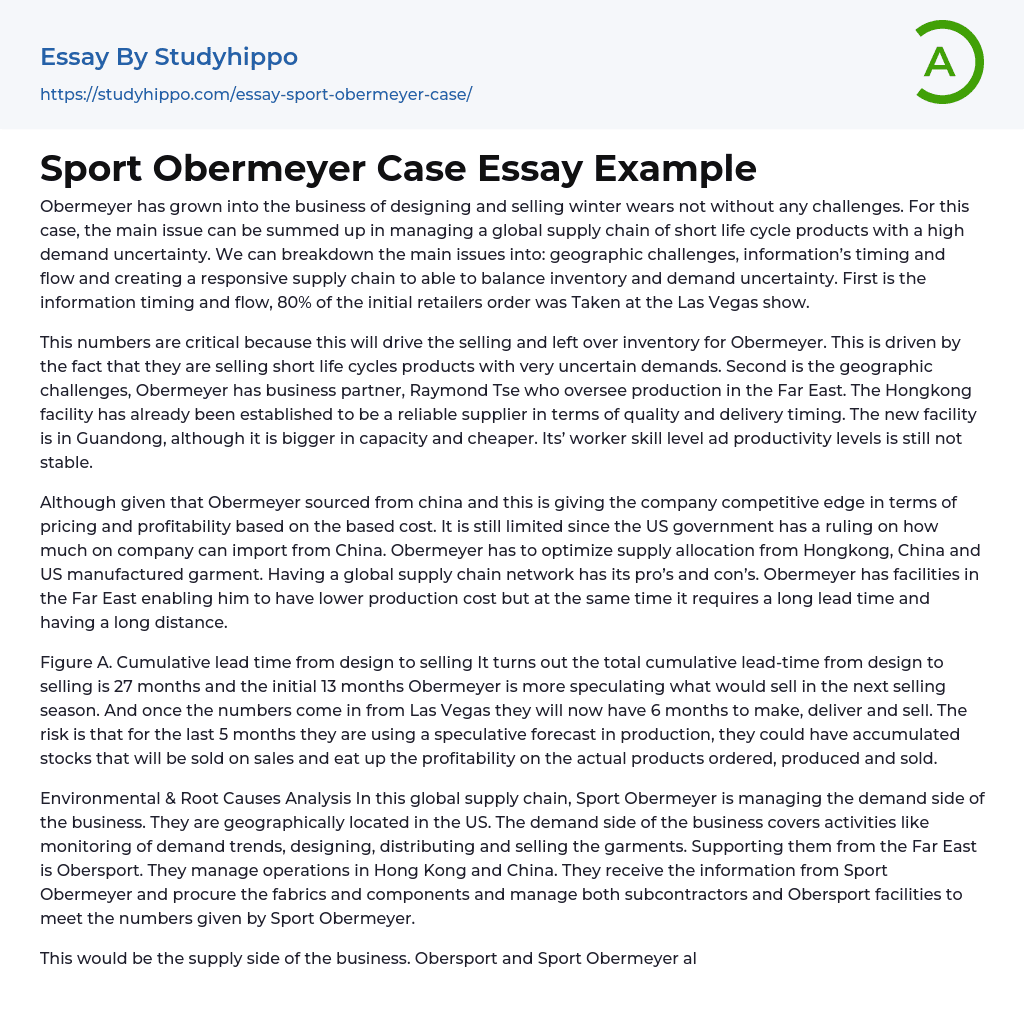Obermeyer has developed into a business that designs and sells winter clothing, a journey not devoid of obstacles. The key problem involves managing a worldwide supply chain of short-lifecycle products faced with demand uncertainty. The primary issues can be dissected into: geographic difficulties, the timing and flow of information, and establishing a reactive supply chain capable of striking a balance between inventory and demand uncertainty. To illustrate, the timing and flow of information is a significant issue, as 80% of the initial orders from retailers were received at the Las Vegas show.
These figures play a substantial role as they influence sales and remaining stock for Obermeyer. The driving force behind this scenario is their business model that involves selling products with short life cycles and volatile demand. Additionally, Obermeyer's geographic hurdles bring their own set of challenges. They
...have a business associate, Raymond Tse, who manages production operations in the Far East. The Hong Kong-based facility has proven to be a dependable supplier regarding quality and prompt delivery. However, despite its greater capacity and lower costs, the Guandong facility has yet to achieve stability in workers' expertise and productivity levels.
Obermeyer has been drawing on resources from China, which presents a competitive advantage with regards to pricing and profitability based on the base cost. However, this is constrained due to the US government's regulation limiting the amount that can be imported from China. Thus, Obermeyer needs to strategically allocate resources from Hong Kong, China, and US garment manufacturing. Operating a global supply chain undoubtedly has its advantages and disadvantages. Obermeyer's facilities in the Far East allow for lower production costs, however, this requires extensive lea
time and distance.
Diagram A shows the total progressive time span from product design to sales, which is approximately 27 months. In the initial 13 months, Obermeyer essentially predicts which items will be popular in the following sales season. Once the data arrives from Las Vegas, they have a six-month window to manufacture, deliver and sell their products. However, the risk lies in the final 5 months where production is based largely on forecasted speculation. This could result in an excess of stock which would then have to be sold at discounted prices, negatively impacting the revenue generated from products that were actually ordered, manufactured and sold.
Sport Obermeyer takes charge of the demand-side operations in the international supply chain, managing activities such as overseeing demand trends, designing, distributing and selling clothing. They are based in the United States. At the same time in the Far East, Obersport backs them up. Running activities from Hong Kong and China, they get data from Sport Obermeyer in order to source the fabrics and components needed. They also handle both subcontractors and Obersport facilities in order to meet the quotas provided by Sport Obermeyer. The aforementioned facts are key points in the analysis of environmental aspects and underlying causes.
On the supply end of the business spectrum, we have two distinct entities, Obersport and Sport Obermeyer, despite their business partnership. Diverse company visions, work cultures, knowledge bases, and business perspectives set them apart. Regarding demand management, Sport Obermeyer overly relies on the Las Vegas Show, in contrast to Obersport which is already manufacturing items that often diverge substantially from what the Las Vegas show presents. Case exhibit 6 illustrates the protracted
time periods and high minimum orders associated with fabric and key components.
Obersport is concluding the 93/94 sales year close to 800 SKU's, as indicated in exhibit 3. The same exhibit also displays a decrease to nearly 15 design styles. Despite the consistency in the average of 4 colors per style over the past five years, there has been an increase in the average number of sizes to 8. The US has specific laws protecting its local economy, restricting the importation of Chinese products. This is another aspect that needs consideration while optimizing the distribution of production volumes between China and North America.
- Auction essays
- Balanced Scorecard essays
- Business Plans essays
- Expense essays
- Income essays
- Net Income essays
- Security Guard essays
- Singapore Airlines essays
- Battle essays
- Intranet essays
- Maintenance essays
- Simulation essays
- Inn essays
- Chief Executive Officer essays
- Convenience Store essays
- Firm essays
- Training And Development essays
- Unilever essays
- Variable Cost essays
- Virgin Group essays
- Bargaining essays
- Entity essays
- Pest analysis essays
- Academia essays
- Higher Education essays
- Language Learning essays
- Studying Business essays
- Education System essays
- Study essays
- First Day of School essays
- Scholarship essays
- Pedagogy essays
- Curriculum essays
- Coursework essays
- Studying Abroad essays
- Philosophy of Education essays
- Purpose of Education essays
- Brainstorming essays
- Educational Goals essays
- Importance Of College Education essays
- Brown V Board of Education essays
- The Importance Of Higher Education essays
- Online Education Vs Traditional Education essays
- Academic And Career Goals essays
- Academic Integrity essays
- Brown Vs Board Of Education essays
- Distance learning essays
- Technology in Education essays
- Vocabulary essays
- Writing Experience essays




